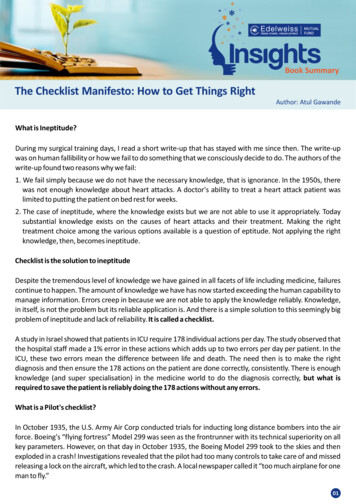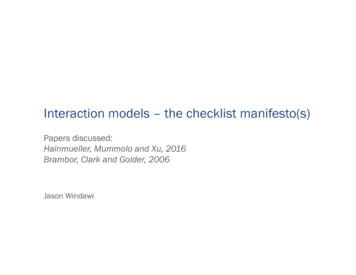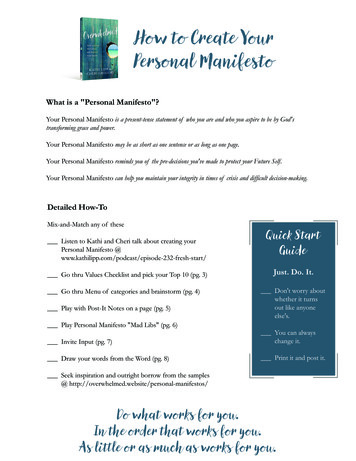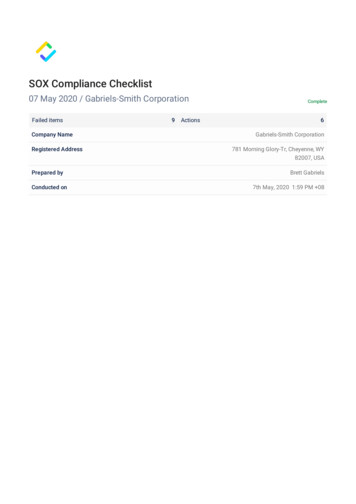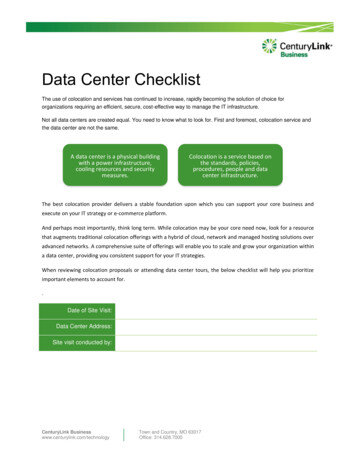
Transcription
THE CHECKLISTMANIFESTOHow to Get Things RightATUL GAWANDEATUL GAWANDE is a general surgeon in Boston, a staff writer for The New Yorker and an assistant professorat Harvard Medical School and the Harvard School of Public Health. He has written two other books, Better: ASurgeon’s Notes on Performance and Complications: A Surgeon’s Notes on an Imperfect Science.The Web site for this book is at www.thechecklistmanifesto.com.ISBN 978-1-77544-680-4SUMMARIES.COM is a concentrated business information service. Every week, subscribers are e-mailed aconcise summary of a different business book. Each summary is about 8 pages long and contains thestripped-down essential ideas from the entire book in a time-saving format. By investing less than one hourper week in these summaries, subscribers gain a working knowledge of the top business titles. Subscriptionsare available on a monthly or yearly basis. Further information is available at www.summaries.com.
The Checklist Manifesto - Page 1MAIN IDEAIn complex situations – such as those which arise in almost every profession and industry today – the solutions to problems aretechnical and demanding. There are often a variety of different ways to solve a problem. It’s all too easy to get so caught up dealingwith all these complexities that the most obvious and common sense immediate solutions are not tried first. To overcome thisproblem, take a leaf from the commercial aviation industry and develop checklists people can use to make sure every base is coveredquickly and concisely. Checklists are a forgotten or ignored business tool. It’s time for them to come in from the cold.“Here, then, is our situation at the start of the twenty-first century: We have accumulated stupendous know-how. We have put it in thehands of some of the most highly trained, highly skilled, and hardworking people in our society. And with it, they have accomplishedextraordinary things. Nonetheless, that know-how is often unmanageable. Avoidable failures are common and persistent, not tomention demoralizing and frustrating, across many fields – from medicine to finance, business to government. And the reason isincreasingly evident: the volume and complexity of what we know has exceeded our individual ability to deliver its benefits correctly,safely, or reliably. Knowledge has both saved us and burdened us. That means we need a different strategy for overcoming failure,one that builds on experience and takes advantage of the knowledge people have but somehow also makes up for our humaninadequacies. And there is such a strategy – though it will seem almost ridiculous in its simplicity, maybe even crazy to those of uswho have spent years carefully developing ever more advanced skills and technologies. It is a checklist.”– Atul GawandeKnowledgeThe ProblemExtremecomplexityand specializationþþþExperienceThe SolutionDevelop checklists andthen consistently useand improve themValidationChecklists have been in use inthe aviation industry for manyyears and have recentlygenerated some superior resultsin the medical field as wellThe Problem . . . . . . . . . . . . . . . . . . . . . . . . . . . . . . . . . . . . . . . . . . . . . . . . . . . . . . Pages 2 - 3Modern medical care is a good example of how professional fields of expertise have developed in recentyears with the coming of the information revolution. Today’s medical practitioners are extremely educatedand superbly experienced in their areas of expertise, but that increase in specialization is bringing aboutsome unintended consequences. Everyone is getting so busy in their respective areas of expertise somebasic and preventable patients deaths are occurring.The Solution . . . . . . . . . . . . . . . . . . . . . . . . . . . . . . . . . . . . . . . . . . . . . . . . . . . . . . Pages 3 - 5Many industries today have entered what could be termed their own “B-17 phases”. Large and growingchunks of what software designers, financial managers, firefighters, police officers and doctors do are nowmuch too complex to be carried out from memory alone. The solution is to follow commercial aviation’slead and integrate the more systematic use of checklists into day-to-day operations.Validation . . . . . . . . . . . . . . . . . . . . . . . . . . . . . . . . . . . . . . . . . . . . . . . . . . . . . . . Pages 6 - 8Checklists may seem like a ridiculously simple concept in a complex world but the evidence is they work.Good checklists get the routine and obvious tasks out of your mind so you can instead focus on the hardstuff. They have been shown to work in venture capital investment just as effectively as they work incommercial aviation and medicine. Chances are they will work their magic in every industry imaginable –and will work even better in the future as everything gets progressively more complex.
The Checklist Manifesto - Page 2The ProblemExtremecomplexityand specializationModern medical care is a good example of how professionalfields of expertise have developed in recent years with thecoming of the information revolution. Today’s medicalpractitioners are extremely educated and superbly experiencedin their areas of expertise, but that increase in specialization isbringing about some unintended consequences. Everyone isgetting so busy in their respective areas of expertise some basicand preventable patients deaths are occurring.Medical care in the twenty-first century is highly impressive.Saves are made daily of patients who just a few years ago wouldhave faced certain death. For all those achievements, however,a surprising number of patients still die due to some very basichuman errors:nMedical machinery which has not been properly serviced andtherefore which is not working when it is needed in anemergency setting.nTeams that can’t get moving fast enough in order to perform aneeded procedure.nSomeone somewhere along the line forgets to wash theirhands and an infection takes hold with fatal consequences.The World Health Organization has estimated there are nowmore than thirteen thousand different diseases, syndromes andtypes of injury. For nearly all of them, science has providedthings that can be done to help – either by curing the disease orby reducing the harm and misery involved. The challenge is foreach condition, the treatment steps are different and they arealmost always complex. The average clinician has about sixthousand drugs and around four thousand medical and surgicalprocedures to choose from. This is a lot for someone to get right,even someone who has been trained for many years.On any given day in the United States, around ninety thousandpeople will be admitted to intensive care. That means over ayear, some five million Americans will receive intensive care andalmost everyone will get to see the inside of an intensive care unitover the course of their lifetime. According to one study, theaverage patient in intensive care will require 178 individualactions per day – administering a drug at the right time, turningthe patients regularly to avoid bed sores, having someone bathethem and change their sheets without disturbing tubes or lineswhich may been inserted, etc. Every one of these actionsinvolves risks and doctors and nurses do a remarkable job inminimizing mistakes but even an error of just one percent willmean two mistakes per day per patient are being made.“This is the reality of intensive care: at any point, we are as apt toharm as we are to heal. Line infections are so common they areconsidered a routine complication. ICUs put five million lines intopatients each year, and national statistics show that after tendays 4 percent of those lines become infected. Line infectionsoccur in eighty thousand people a year in the United States andare fatal between 5 and 28 percent of the time, depending onhow sick one is at the start. Those who survive line infectionsspend on average a week longer in intensive care. And this is justone of many risks. All in all, about half of ICU patients end upexperiencing a serious complication, and once that occurs thechances of survival drop sharply.”– Atul GawandeThe medical profession’s answer to all this increasing complexitythus far has been:SpecializationSuperspecializationnAreas of specialization have been broken down further into morenarrowly focused areas of superspecialization. Clinicians trainuntil they can do one thing better than anyone else. For example,where there were once anesthesiologists who handled paincontrol and patient stability during operations, today there arepediatric anesthesiologists, cardiac anesthesiologists, obstetricanesthesiologists, neurosurgical anesthesiologists and manymore.In the early twentieth century you could get a license to practicemedicine if you had a high school diploma and a one-yearmedical degree. By the end of the twentieth century, to become adoctor you needed a college degree, a four-year medical degreeand then an additional three to seven years of residency trainingin an individual field of practice like pediatrics, surgery,neurology and so forth. Today, even that level of preparation isinadequate. Most doctors also do fellowships which involve oneto three years of additional training. Doctors typically don’t startpracticing independently until they are in their mid-thirties ofolder.“The result of the recent decades of ever-refined specializationhas been a spectacular improvement in surgical capability andsuccess. Where deaths were once a double-digit risk of evensmall operations, and prolonged recovery and disability was thenorm, day surgery has become commonplace. Yet given howmuch surgery is now done – Americans today undergo anaverage of seven operations in their lifetime, with surgeonsperforming more than fifty million operations annually – theamount of harm remains substantial. We continue to haveupwards of 150,000 deaths following surgery every year – morethan three times the number of road traffic fatalities. Moreover,research has consistently showed that at least half our deathsand major complications are avoidable. The knowledge exists.But however supremely specialized and trained we may havebecome, steps are still missed. Mistakes are still made.Medicine, with all its dazzling success but also frequent failures,therefore poses a significant challenge: What do you do whenexpertise is not enough? What do you do when even thesuper-specialists fail?”– Atul GawandeWhat’s happening in the medical care field is also happening inone industry after another right across the entire economy. In theconstruction industry, for example, the traditional approach tobuilding anything was to go out and hire a master builder whowould design, engineer and then oversee construction frombeginning to end. Master builders were responsible for theconstruction of major buildings like the Empire State Buildingand the United States Capitol building. By the middle of thetwentieth century, however, construction went down the sameroad of specialization medical care has followed. Firstarchitectural and engineering design split from construction andthen piece by piece each area of construction know-how got split
The Checklist Manifesto - Page 3off into its own area of specialization. The building industry todayhas at least sixteen trades including architects, structuralengineers, electrical engineers, mechanical engineers,ventilation engineers and so on. The entire industry has beenforced to evolve in order to function effectively.Increasing complexity has also been a problem in the aviationindustry. In 1935, the U.S. Army Air Corps held a competition forairplane manufacturers who wanted to build the military’snext-generation bomber. Boeing Corporation entered its Model299 which looked like a figurative “slam dunk” – it carried fivetimes as many bombs as the army had requested and hadalmost twice the range of previous bombers. On October 30,1935, a crowd of army brass and manufacturing executivesgathered to watch the 299’s maiden test flight.The plane roared down the runway, lifted off smoothly andclimbed normally to three hundred feet at which point it stalled,turned on one wing and crashed to the ground in a fiery explosionkilling two of its five crew members including the pilot, MajorPloyer P. Hill. The army had planned to order sixty-five of theaircraft but in light of the crash, the army ordered Douglas’sairplane instead – which almost sent Boeing into bankruptcy.The crash investigation revealed nothing mechanical had gonewrong with the 299 and therefore was attributed to “pilot error.”The report also noted flying the 299 was substantially morecomplex than previous aircraft. The new plane required the pilotto attend to the four engines, each with their own fuel-air mixes tobe tuned, to operate the retractable landing gear, wing flaps andelectric trim tabs, and to adjust the pitch of the constant-speedpropellers. Major Hill had been so busy with these tasks he hadneglected to release a locking mechanism on the elevator andrudder controls. As one newspaper summed it up, the BoeingModel 299 was “too much airplane for one man to fly.”The army did ultimately decide to purchase a few Model 299sfrom Boeing as test planes. A few pilots, who liked the look of theplane, decided to get together and figure out a way to make the299 more user-friendly. They did not suggest more pilot trainingwas the solution – Major Hill had been the Air Corp’s chief of flighttesting and it was difficult to imagine someone having moreexperience and expertise than him. Instead, this ad-hoc groupcame up with a simple approach to complexity – they created thefirst pilot’s checklist. They decided flying this new plane was toocomplicated to be left to the memory of any one person, even anexpert in their field.Their checklist wasn’t all that complex at first. In fact, it wassimple enough and brief enough to fit on a single index card. Itlisted step-by-step checks to be done before takeoff, during flightand then before landing. It included all the stuff pilots alreadyknew to do including checking the brakes were released, thatinstruments were set correctly, that doors and windows wereclosed, that the elevator controls were unlocked and so forth.However, using these simple checklists, the pilots went on to flythe Model 299 a total of 1.8 million miles without one incident.The army ultimately ordered almost thirteen thousand ofBoeing’s Model 299s which came to be designated as the B-17or “Flying Fortress”. As a result, the United States gained adecisive air advantage in the Second World War. The B-17would go on to become the backbone of the Allies’ devastatingbombing campaign which ultimately led to the surrender of NaziGermany. What started out as a disaster for Boeing ended upbeing the U.S. trump card during World War II, thanks to the factpilots were willing to use checklists.The SolutionExtremecomplexityand specializationDevelop checklists andthen consistently useand improve themMany industries today have entered what could be termed theirown “B-17 phases”. Large and growing chunks of what softwaredesigners, financial managers, firefighters, police officers anddoctors do are now much too complex to be carried out frommemory alone. The solution is to follow commercial aviation’slead and integrate the more systematic use of checklists intoday-to-day operations.In a complex high-pressure environment, experts always comeup against two main difficulties:It’s easy to overlook routinematters under the strain ofpressing immediate demandsDifficultiesPeople can lull themselvesinto skipping steps evenwhen they remember themnHuman memory can become fallible when there are veryserious and pressing events going on. When baking a cake,you might get distracted by a phone call and forget to add onekey ingredient. When you’ve got a patient who is throwing upand a family member demanding to know what’s going on,you can forget to check the patient’s pulse. When you’repreparing for takeoff, you can forget to remove the lock fromyour flight controls.nIt’s similarly easy to talk yourself into skipping steps becausemost of the time, they won’t be critical matters. You mightrationalize that for the last fifty patients you saw, measuringtheir four vital signs didn’t really matter. This works just fineuntil one day a problem slips through which you could havepicked up on immediately if you’d just done your routinechecks. (By the way, the recording of the four vital signs of apatient didn’t become routine practice until the 1960s whennurses embraced the idea and redesigned their patient chartsto include the data.)Checklists provide protection against these two key difficulties.By making the minimum necessary steps explicit and verifiable,a discipline is instilled which can lead to higher levels ofperformance. Checklists can exist in a number of differentformats – anything from forms people fill out themselves tomedication timing charts, written care plans for each patient andso forth. Similarly, items on a checklist can be READ-AND-DO(where you read the item and then go do what’s specified) orCHECK-ONCE-DONE (where you confirm you’ve carried outthe action specified.) The way checklists can be put together isunlimited and therefore checklists can be developed and thenapplied to any and all situations.
The Checklist Manifesto - Page 4KnowledgeþþþExperienceSo why do checklists work? In a nutshell, checklists ensurepeople are applying all the knowledge and expertise they haveconsistently well. Furthermore, checklists start a self-sustainingvirtuous cycle. The more checklists get developed and used thebetter they become.Most people assume checklists only work in routine andrepetitive situations like preparing to takeoff in an airplane butthat’s not always the case. Consider the example of whathappened when Hurricane Katrina hit New Orleans on August29, 2005. Within a matter of just a few hours, the city’s telephonelines, cell towers and electrical power went out – makingcommunication difficult. At much the same time, the leveesprotecting the city were breached.A lone agent of FEMA (Federal Emergency ManagementAgency) managed to get a helicopter ride over New Orleans thatafternoon and reported seeing widespread flooding, hundreds ofpeople stranded on rooftops and bodies floating in the water. Hefiled an urgent report by e-mail because all other means ofcommunication had been lost. The only problem with that wasFEMA’s top official didn’t use e-mail and therefore FEMA didn’teven know there was an emergency until TV pictures of thedisaster were broadcast the following day. By then, 80 percent ofthe city was flooded, forty thousand refugees were stranded atthe New Orleans Superdome and Convention Center, fivethousand people were stranded on an overpass on Interstate 10,hospitals were without power and widespread looting had brokenout as people became desperate for food and water. For days,the federal government, the state government and the localgovernment then debated who should respond while thesituation on the ground steadily deteriorated.By contrast, Wal-Mart had 126 stores in the New Orleans regionclosed due to damage and power outages. CEO Lee Scott toldeveryone, “This company will respond to the level of thisdisaster. A lot of you are going to have to make decisions aboveyour level. Make the best decision that you can with theinformation that’s available to you at the time, and above all, dothe right thing.” Within forty-eight hours, twenty thousandWal-Mart employees and their family members were accountedfor and the company’s priority shifted to figuring out what couldbe done to help the people of New Orleans.Acting solely on their own authority, Wal-Mart’s store managersstarted distributing diapers, water, baby formula and ice toresidents affected by the flood. First responders from FEMAwere provided with food, sleeping bags, toiletries and rescueequipment even though there was no formal requisition processin place. Instead, a crude paper-slip record system was used tokeep track of these supplies.The assistant manager of one Wal-Mart which had beenengulfed by a thirty-foot surge of water ran a bulldozer throughthe side of the building, loaded it with as much stuff as she couldsalvage and gave the items away in the parking lot. When thelocal hospital told her it was running short of drugs, that sameassistant manager broke into the store’s pharmacy – and waslater lauded by upper management for taking the initiative.Wal-Mart set up an emergency response team (which evenincluded a member of the Red Cross) and within two days hadtractor trailers loaded with food, water and emergencyequipment rolling into New Orleans. Employees set uptemporary mobile pharmacies which provided evacuees withfree medications. Wal-Mart even managed to supply theNational Guard with food and water a day before the federalgovernment could respond. By the end, Wal-Mart would sendinto New Orleans 2,498 trailer loads of emergency supplies anddonate more than 3.5 million in merchandise to area sheltersand command centers.The moral of this story isn’t the suggestion the private sector isbetter than the public sector in handling complex, emergencysituations. Lots of major New Orleans businesses were shown tobe inadequately prepared for such an eventuality and the localpolice and firefighters did an incredible job in serving theircommunities at a time of great need. The real lesson was thatunder conditions of true complexity, a centralizedcommand-and-control decision chain doesn’t work all that well.Instead, you’ll get better results by codifying what needs tohappen into a simple checklist and then giving people thefreedom to act and adapt using their best judgment while at thesame time meeting specified expectations.Put another way, checklists work well in complex situationsbecause they hit a balance between what usually seem to beconflicting virtues:FreedomCraftSpecialized abilityþþþDisciplineProtocolGroup collaborationChecklists help people achieve a balance between these virtuesby supplying a set of checks to ensure the basic, critical stuff isnot overlooked while at the same time ensuring people talk andcoordinate together around common, shared aims.“Under conditions of complexity, not only are checklists a help,they are required for success. There must always be room forjudgment, but judgment aided – and even enhanced – byprocedure.”– Atul GawandeA good example of how checklists can pop up in unusual placeswith great effect is the story of rock band Van Halen. They wereone of the first big name bands to take huge roadshowproductions into third-level markets. Whereas the usual stageshows would turn up at a venue with two or threeeighteen-wheelers of stage equipment, Van Halen would roll intotown with nine eighteen-wheelers packed full of gear. With thatmuch equipment, there was always a worry the stage flooringwouldn’t be strong enough or well enough reinforced to take allthe extra weight.
The Checklist Manifesto - Page 5To avoid problems, the Van Halen management team wouldhave a contract with concert promoters which was huge –described by some as being like a version of the Chinese YellowPages. Buried in that contract was Clause 126 which specified abowl of M&Ms was to be placed backstage which contained nobrown M&Ms. If the brown M&Ms were not removed, the showwould be cancelled but full compensation would be paid to theband.line proper which details the variances which have cropped upand who will talk to whom by when. Everyone gets together,reviews the possible options for moving forward, make adecision, readjust the construction schedule to allow for whatneeds to be done and then everyone signs off on what has beendone.TradesAlthough at first glance this would appear to be another insanedemand of power-mad celebrities, it was actually a checklist itemto ensure the promoters had fully understood and complied withthe technical requirements of staging the show.“When I would walk backstage, if I saw a brown M&M in thatbowl, well we’d line-check the entire production. Guaranteedyou’re going to arrive at a technical error. Guaranteed you’d runinto a problem.”– David Lee RothOne time Van Halen had to cancel a show in Colorado becausebrown M&Ms alerted them to the fact their staging would havefallen through the arena floor. Other times they found accessdoors were too small and so forth. By integrating a simple butbizarre sounding checklist item into their performance contractsin this way, the band’s management team were able to tell whichpromoters had been thorough and which were trying to cutcorners.The other good thing about checklists is they can be used tocoordinate the activities of diverse teams quickly and concisely.Take the construction of a skyscraper, for example.“In designing a building, experts must take into account adisconcertingly vast range of factors: the makeup of the localsoil, the desired height of the individual structure, the strength ofthe materials available, and the geometry, to name just a few.Then, to turn the paper plans into reality, they presumably faceequally byzantine difficulties making sure that all the differenttradesmen and machinery do their job the right way, in the rightsequence, while also maintaining the flexibility to adjust forunexpected difficulties and changes. Yet builders clearlysucceed. They safely put up millions of building all over theglobe. And they do so despite the fact that construction work hasgrown infinitely more complex over the decades. Moreover, theydo it with a front-line workforce that regards each particular job –from pile-driving to wiring intensive-care units – much the waydoctors, teachers, and other professionals regard their jobs; asspecialized domains in which others should not interfere.”– Atul GawandeTo keep a construction project organized, a constructionschedule is developed which is in essence a very long and highlydetailed sequential checklist of tasks to be done. This will beloaded into a computer scheduling package which usually thenadds color coding such as making red items the critical stepswhich need to be completed before other items can be done.Materials delivery schedules and more detailed checklists for thevarious tradespeople can then be generated from the overallschedule. Subcontractors and other independent experts canthen carry out day-by-day checks to verify that everything hasbeen correctly done and to a proper standard of finish.So what happens when things don’t go to plan or when problemscrop up? Well, in simple terms, people from the various tradesinvolved talk with other and figure things out. On most buildingprojects, a schedule will be run alongside the construction timeSpecialistsþþþOfficialsExpertsIn practical terms, the major advance in the construction industryin recent times has been its perfection of tracking checklist itemsand communication. On most major building projects today,workers can e-mail digital photos of problems which arise toproject managers who then forward them on to the maincontractors and anyone else who might potentially be required tosign off on the fix. Complexity is reduced by having everyone talkthings through as a group, with each trade bringing theirspecialized knowledge to bear on unexpected problems. Onceeveryone agrees on the best way forward, the solution is thenapplied and construction moves forward.“The construction industry’s checklist process has clearly notbeen foolproof at catching problems. Nonetheless, its record ofsuccess has been astonishing. In the United States, we havenearly five million commercial buildings, almost one hundredmillion low-rise homes, and eight million or so high-riseresidences. We add somewhere around seventy thousand newcommercial buildings, and one million new homes each year. But‘building failure’ – defined as partial or full collapse of afunctioning structure – is exceedingly rare, especially forskyscrapers. According to a 2003 Ohio State University study,the United States experiences an average of just twenty serious‘building failures’ per year. That’s an annual avoidable failurerate of less than 0.00002 percent. The checklists work.”– Atul Gawande“Its unnerving to think we allow buildings to go up in the midst ofour major cities, with thousands of people inside and tens ofthousands more living and working nearby. Doing so seemsrisky and unwise. But we allow it based on trust in the ability ofexperts to manage the complexities. They in turn know betterthan to rely on their individual abilities to get everything right.They trust instead in one set of checklists to make sure simplesteps are not missed or skipped and in another to make sure thateveryone talks through and resolves all the hard and unexpectedproblems.”– Atul Gawande
The Checklist Manifesto - Page 6ValidationChecklists have been in use inthe aviation industry for manyyears and have recentlygenerated some superior resultsin the medical field as wellChecklists may seem like a ridiculously simple concept in acomplex world but the evidence is they work. Good checklists getthe routine and obvious tasks out of your mind so you can insteadfocus on the hard stuff. They have been shown to work in venturecapital investment just as effectively as they work in commercialaviation and medicine. Chances are they will work their magic inevery industry imaginable – and will work even better in the futureas everything gets progressively more complex.“We don’t like checklists. They can be painstaking. They’re notmuch fun. But I don’t think the issue here is mere laziness.There’s something deeper, more visceral going on when peoplewalk away not only from saving lives but from making money. Itsomehow feels beneath us t o use a c hecklist, anembarrassment. It runs counter to deeply held beliefs about howthe truly great among us – those we aspire to be – handlesituations of high stakes and complexity. The truly great aredaring. They improvise. They do not have protoc
The Checklist Manifesto - Page 1 MAIN IDEA In complex situations – such as those which arise in almost every profession and industry today – the solutions to problems are technical and demanding. There are often a variety of different waysto solve
